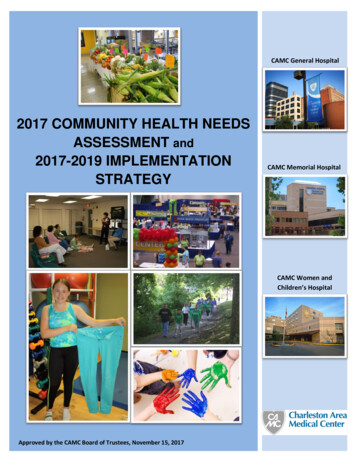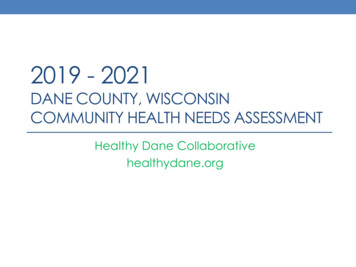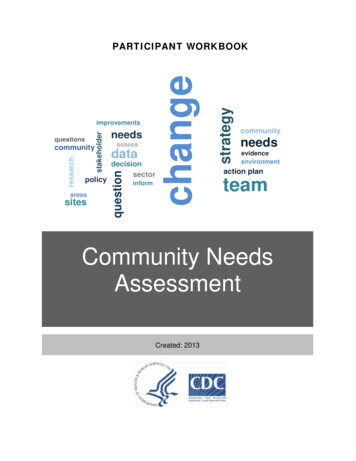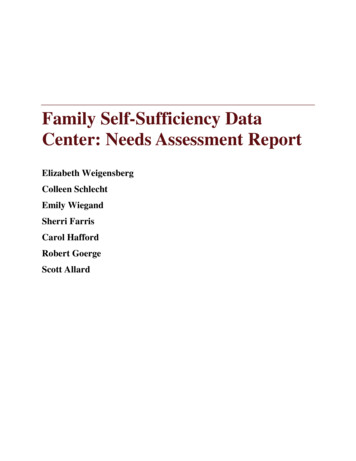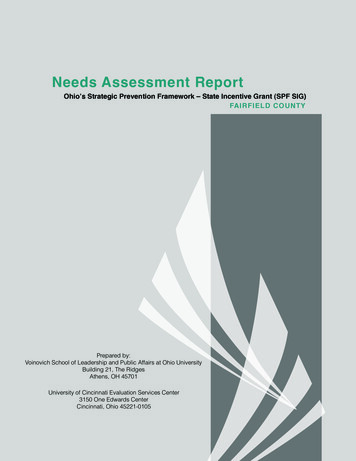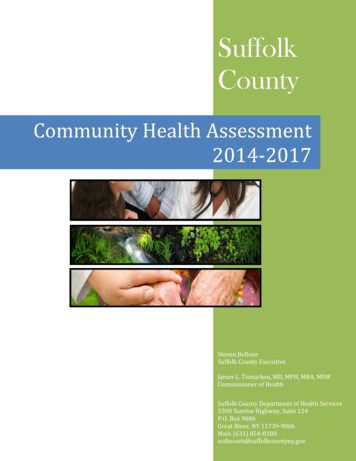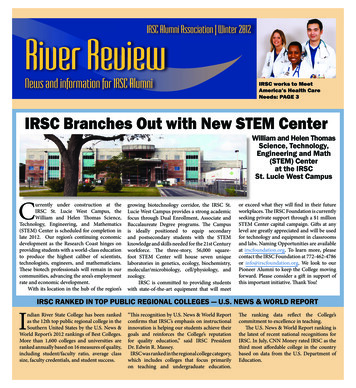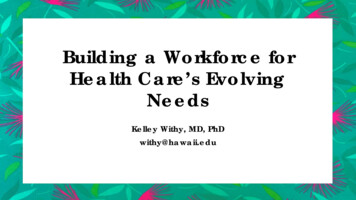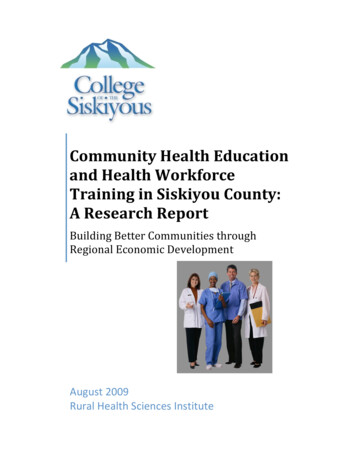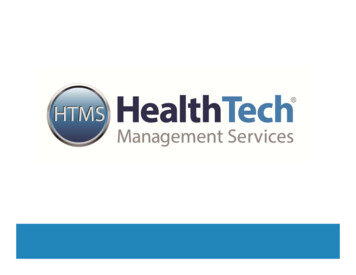
Transcription
HealthTechA Strong History of Performance HealthTech has been providing leadership and strategic resources tocommunity hospitals since 1971– Operated as Brim Healthcare prior to 10/1/2010. Founded by healthcare pioneerGene Brim– Headquartered in Brentwood, Tennessee with regional offices in Madison, WI &Plano, TX– Affiliated company of GAFFEY Healthcare ‐ a leading Revenue Cycle Management andData Analytics company HealthTech provides consulting and recruitment services to over 50 hospitalsnationwide Client Profiles – Nationally and Internationally– Not‐for‐Profit Systems– Acute, sub‐acute hospitals– Rural, Community Hospitals Copyright HealthTech Management Services. All Rights Reserved Page 2– Critical Access Hospitals– District/Governmental Hospitals
HealthTech Overview HealthTech provides data driven consulting, managementsupport and executive placement services to communityhospitals ‐ bringing fresh practices that create results HealthTech’s leadership views challenges as new opportunities Organizational Leadership & Services Financial Leadership & Services Supply Chain & GPO Consulting Clinical Services Consulting Revenue Cycle Consulting Strategic Planning Copyright HealthTech Management Services. All Rights Reserved Page 3Physician & ProfessionalRecruitmentInformation SystemsConsultingHuman Resources ConsultingPhysician Practice/Clinic Management Consulting
Our Team: We have walked a mile in your shoesHealthTech possesses an strong management team with deep operational expertise,extensive industry experience and a track record of delivering results for our clientsMore than 20 years of experience in both health careand technology industries. Previously served as SeniorVice President at MedCath Corporation, OperationsCFO at IASIS Healthcare, CEO US Operations forCraneware, Hospital CFO at Province Healthcare andDivision Director Finance HCAVoss has more than 30 years of healthcareadministration experience including the past 20 yearswith HealthTech Management Services (formerly BrimHealthcare), serving as Executive Vice President andCEO at St. Anthony’s Memorial Hospital in Effingham,Illinois.Greg VossRegional VPDerek MorkelCEOBrings over 37 years of healthcare experience, of which30 years were in the capacity of President and CEO ofhospitals ranging from 200 to 300 beds, with servicesincluding acute care, behavioral health, home care,skilled care and physician practice managementNeil TodhunterPresidentRon WingerRegional VPCertified Public Accountant with over 25 years ofexperience in health care management and has a deepunderstanding of business intelligence technology todrive operating improvements. Previously, he servedas a Division CFO at IASIS Healthcare, HCA and HospitalCFO at Universal HealthMichael JennesseCFO Copyright HealthTech Management Services. All Rights Reserved Page 4Brian MoyerEVP / CIOWinger has more than 35 years healthcareadministration experience, serving as president andCEO of four different not‐for‐profit and for‐profithospitals and health systems, including most recentlyas president and CEO at the Heart Hospital of NewMexico, a 55‐inpatient bed facility in Albuquerque,New Mexico.Moyer served as President and CEO of NOVASTechnology Group, In the 1990's, Moyer was founderand President of MW Technologies, where hedeveloped and sold the TAMS (Total AssetManagement System) product suite into hospitalsacross the Midwest. He is heavily involved in the healthIT community, serving as President of the HIMSSTennessee Chapter.
Our Team: We have walked a mile in your shoesHealthTech possesses an strong management team with deep operational expertise,extensive industry experience and a track record of delivering results for our clientsCarolyn St. CharlesJoy SmithRegional Chief Clinical Officercarolyn.stcharles@ht‐llc.comSenior Patient Financial Consultantjoy.smith@ht‐llc.comDiane BradleyMichael LiebRegional Chief Clinical Officerdiane.bradley@ht‐llc.comDirector, Physician Practice Managementmichael.lieb@ht‐llc.comJulie HaynesJohn FreemanStrategic Planning Consultantjulie.haynes@ht‐llc.comAssistant Vice Presidentjohn.freeman@ht‐llc.comSusan MurphyKevin StringerExecutive Director Supply ChainResourcessue.murphy@ht‐llc.com Copyright HealthTech Management Services. All Rights Reserved Page 5Assistant Vice Presidentkevin.stringer@ht‐llc.com
Value PropositionHealthTech ServicesHospital Benefits Leadership & Medical Staffdevelopment Executive Placement Services Clinical Compliance & ResourceConsulting Business Intelligence & Analytictools Strategic Planning & MarketShare Analysis Supply Chain Optimization Productivity Monitoring Tools Financial Statement, budgeting,and Revenue Cycle Services Market development andgrowth Successful physicianrecruitment/retention Elimination of lost revenue Savings on hospital suppliesand equipment Reduction of operatingexpenses Improved working capitalmanagement Improved clinical quality Positive accreditation results Quality and service awards Enhanced communityrecognition Copyright HealthTech Management Services. All Rights Reserved Page 6
For more information aboutHTMS products and services Neil Todhunter, President– Email: Neil.todhunter@ht‐llc.com– Phone: 814‐657‐1563 John Smith, Vice President of Business Development– Email: John.smith@ht‐llc.com– Phone: 615‐584‐6367 Visit our websites– http://www.htmsinc.com– http://www.gaffeyhealth.com Copyright HealthTech Management Services. All Rights Reserved Page 7
Community Health Needs Assessment2015April 28, 2015Carolyn St.Charles, BSN, MBARegional Chief Clinical Officer HTMS
Do Not Distribute Beyond Your FacilityHealthTech hopes that the information contained herein will be informative and helpful onindustry topics. However, please note that this information is not intended to be definitive.HealthTech and its affiliates expressly disclaim any and all liability, whatsoever, for any suchinformation and for any use made thereof. HealthTech does not have responsibility for nor doesit develop or provide policies intended for direct use by any hospital, clinic or their respectivepersonnel. Any and all responsibility for such and for compliance with state and federalrequirements remains exclusively with the hospital, clinic or their respective personnel.HealthTech recommends that hospitals, clinics, their respective personnel, and all other thirdparty recipients of this information consult original source materials and qualified healthcareregulatory counsel for specific guidance in adopting and customizing policies for your particularhealthcare entity’s use. Copyright HealthTech Management Services. All Rights Reserved Page 9
GuidelinesFinal rules published on December 31, 2014The Affordable Care Act added 501(r) to the Internal Revenue Code.This provided that hospital organizations will not be treated astax‐exempt under 501(c)(3) unless they meet certain requirements.All of the provisions apply to taxable years beginning afterMarch 23, 2010, except CHNA.The CHNA assessment and implementation strategy requirementsbecame effective for taxable years beginning after March 23, 2012.The final rules apply to taxable years beginning afterDecember 29, 2015. For earlier years, hospital may rely on areasonable, good faith interpretation of the statute.Published in the Federal RegisterFederal Register / Vol. 79, No. 250 / Wednesday, December 31, 2014 / Rules and Regulations Copyright HealthTech Management Services. All Rights Reserved Page 10
Guidelines1. Establish written financial assistance and emergency medical carepolicies.2. Limit amounts charged for emergency or other medicallynecessary care to individuals eligible for assistance under thehospital's financial assistance policy.3. Make reasonable efforts to determine whether an individual iseligible for assistance under the hospital’s financial assistancepolicy before engaging in extraordinary collection actions againstthe individual.4. Conduct a community health needs assessment (CHNA) andadopt an implementation strategy at least once every threeyears.– A 50,000 excise tax will be imposed on a hospital that fails to meet theCHNA requirements with respect to any taxable year. Copyright HealthTech Management Services. All Rights Reserved Page 11
Some . of the reasons for 501(r)1. Excessive Charges2. Absence of financial assistance3. Harsh billing and collection practice–––Debt collectors in emergency departmentsWithholding treatment for people with outstanding billsWage garnishment and liens4. Failure of nonprofit hospitals to invest in community health2013 New England Journal of MedicineHospitals on average spent 7.5% of their operating revenue on community benefitactivities, less than 0.5% of hospital expenditures were allocated to community healthimprovement activities for which there is no expectation of payment Copyright HealthTech Management Services. All Rights Reserved Page 12
Community Health Needs AssessmentA community health needs assessmentis a systematic process involving the communityto identify and analyze community health needsand assets in order to prioritize those needs,and to plan and act upon significant unmetcommunity health needs. Copyright HealthTech Management Services. All Rights Reserved Page 13
CHNA RequirementsChanges from the draft guidelines and final IRSguidelines published December 2015Additions are noted in REDDeletions are noted in BLUE Copyright HealthTech Management Services. All Rights Reserved Page 14
Conduct a CHNA ‐ Every Three YearsDefine the communityAssess the health needs of the community served by the hospitalSolicit and take into account input from persons who representthe broad interests of that community, including those withspecial knowledge or expertise in public healthDocument the CHNA in a written report that is adopted by anauthorized body of the facilityMake the CHNA report widely available to the public– Must make two subsequent CHNA reports available Copyright HealthTech Management Services. All Rights Reserved Page 15
Define the CommunityDefining the “community” serves as the foundation on which subsequentassessment and implementation strategies decisions are made. The IRS states that hospitals should define community taking into account, “all ofthe relevant facts and circumstances” concerning the service area includinggeographic area served, target populations and principal functions”. The final IRS regulations removed the statement: Hospitals may definecommunity to include populations in addition to its patient populations andgeographic areas outside of those in which its patient population reside. Hospitals may not define their communities in a way that excludes certainpopulations served by the hospital (for example medically underserved, low‐income or minority populations)– Medically underserved populations include populations experiencing healthdisparities or at risk of not receiving adequate medical care as a result of beinguninsured or underinsured or due to geographic, language, financial or other barrier Population must include everyone who receives care without regard to insuranceor eligibility for assistance Copyright HealthTech Management Services. All Rights Reserved Page 16
Assess SignificantCommunity Health NeedsThe Hospital must identify not only significant unmet healthneeds for health care, but also significant health needs arisingfrom social, environmental and behavioral factors that influencehealth (Social determinants of health)These needs may include for example the need to address financial andother barriers to accessing care, to prevent illness, to ensure adequatenutrition, or to address social, behavioral, and environmental factors thatinfluence health Copyright HealthTech Management Services. All Rights Reserved Page 17
Solicit Input to Identify andPrioritize Health NeedsHospitals must solicit and take in to account input from persons who represent thebroad interests of the community, served by the hospital including:1. Those with special knowledge of or expertise in public health2. At least one state, local, or tribal public health department, or equivalentdepartment or agency including State Office of Rural Health, with knowledge ,information , or expertise relevant to the health needs of the community3. Members of medically underserved, low‐income, and minority populations servedby the hospital, or individuals or organizations serving or representing the interestof these populations– Members of medically underserved populations include populations experiencinghealth disparities or at risk of not receiving adequate medical care as a result of beinguninsured or underinsured or due to geographic, language, financial or other barrierThe final IRS regulations removed the statement: “Input from these persons includes anyfinancial or other barriers to access care in the community” Copyright HealthTech Management Services. All Rights Reserved Page 18
Solicit Input to Identify andPrioritize Health Needs4. Written comments received on the facility’s most recentlyconducted CHNA and most recently adopted implementationstrategy5. The facility may also take into account input from a broad rangeof persons serving the community including consumers,nonprofit and community‐based organizations, academicexperts, local government, providers, etc. Copyright HealthTech Management Services. All Rights Reserved Page 19
Solicit Input to Identify andPrioritize Health Needs1. The hospital may determine whether a need is significant basedon all the facts and circumstances2. “The hospital may use any criteria to prioritize the significanthealth needs it identifies, including, but not limited to,– the burden, scope, severity, or urgency of the health need;– the estimated feasibility and effectiveness or possible interventions;– the health disparities associated with the need; or– the importance the community places on addressing the need”3. Hospitals must identify measures and resources such asorganizations, facilities and programs in the community, includingthose of the hospital, potentially available to address those(significant) health needs. Copyright HealthTech Management Services. All Rights Reserved Page 20
Health Needs Include Requisites for the improvement or maintenance ofhealth in both the community at large and in particularparts (such as neighborhoods or populationexperiencing health disparities) Needs to address financial and other barriers toaccessing care, to prevent illness, to ensure adequatenutrition, or to address social, behavioral andenvironmental factors that influence health in thecommunity Copyright HealthTech Management Services. All Rights Reserved Page 21
CHNA DocumentationMost are on IRS Form 990‐H1. A definition of the community served , including demographics, and adescription of how community served was determined2. Description of the process and methods used to conduct the assessment,including:– Data and other information used in the assessment– Methods of collecting and analyzing information– In the case of data obtained from external source material, the CHNA report maycite the source material rather than describe the method of collecting the data– Third parties with which the facility contracted to assist in conducting CHNA,including qualifications of third parties3. A description of how the hospital solicited and took into account input frompersons who represent the broad interests of the community it serves– Summary of input and how it was provided and between what approximate dates– Names of organizations providing input– If input from an organization, name and title of at least one individual in eachorganization, with whom the facility consulted Copyright HealthTech Management Services. All Rights Reserved Page 22
CHNA DocumentationRequirements cont.4. Description of medically underserved, low‐income, or minoritypopulations being represented by organizations or individualsproviding input– Description of primary and chronic disease needs and other healthissues of uninsured persons, low income persons and minority groups5. In the event a hospital solicits but cannot obtaininput from a required source, the CHNA report mustdescribe the hospital's efforts to solicit input fromsuch sources6. Written comments received on most recent CHNA includingimplementation strategy7. Information gaps that impact the facilities ability to assess thecommunity Copyright HealthTech Management Services. All Rights Reserved Page 23
CHNA DocumentationRequirements cont.8. Process and criteria for identifying significant health needs andservices to meet community health needs9. Process and criteria for prioritizing significant health needs andservices to meet community health needs10. Prioritized description of significant health needs and servicesto meet community health needs11. Existing healthcare facilities and resources within thecommunity that are available to respond to the health needs ofthe community12. Evaluation of the impact of any actions taken since hospitalfinished conducting its immediately preceding CHNA to addressthe significant health needs identified in the CHNA Copyright HealthTech Management Services. All Rights Reserved Page 24
Make the CHNA“Widely Available” Written CHNA report must be "conspicuously posted" on thehospital facility's website, or the hospital organization's website The definition of "widely available" contains detailed requirementsfor website posting and document accessibility, including thefollowing:– Hospitals must provide individuals who ask how to access a copywith the direct website address or URL of the web page on whichthe CHNA Report is posted– Website must clearly inform reader how to download the report– Download may not require special equipment or fee– Report must be maintained on the website until two subsequentCHNA reports are made available– Paper copies must be available for public inspection withoutcharge Copyright HealthTech Management Services. All Rights Reserved Page 25
Implementation StrategyThe implementation strategy is adopted on the date it is approved by thegoverning bodyThe implementation strategy must be adopted on or before the 15th day of thefifth month after the end of the same taxable year in which the hospitalconducts the CHNAImplementation plan must include:1.2.3.4.5.Actions the facility intends to take to address the health needAnticipated impact of the actionsPlan to evaluate the impactThe programs and resources the hospital plans to commit to address the health needAny planned collaboration between hospital and other facilities or organizationsAn explanation of reason for not addressing a significant health need, includingresource constraints or a lack of expertise, even if reasons could be mitigatedthrough collaboration Copyright HealthTech Management Services. All Rights Reserved Page 26
A Few Tips1. Collaborate with others2. Build upon existing assessments and information3. Focus on supplementing and validating public health andother data for your community ‐‐‐‐‐ You are not conductinga statistically significant population survey about thehealth of the community4. Plan on how assessment and implementation will beupdated – must be sustainable over time5. For each prioritized need, identify––––goalmeasurable objective(s)indicatorsevaluation plan Copyright HealthTech Management Services. All Rights Reserved Page 27
Self‐Assessment990X1Description of the community served by the facility (geographic area, populations etc.)2Description of how the community served was determined3Description of community demographicsX4List of existing healthcare facilities and resources within the community that are available to respond to thehealth needs of the co
with HealthTech Management Services (formerly Brim Healthcare), serving as Executive Vice President and CEO at St. Anthony’s Memorial Hospital in Effingham, Illinois. Certified Public Accountant with over 25 years of experience in health care management and has a deep understanding of business intelligence technology to drive operating .
